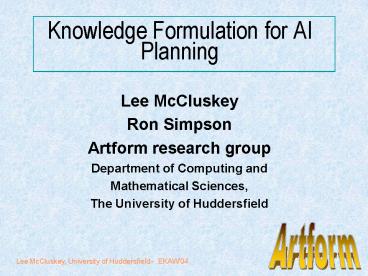Knowledge Formulation for AI Planning PowerPoint PPT Presentation
1 / 18
Title: Knowledge Formulation for AI Planning
1
Knowledge Formulation for AI Planning
- Lee McCluskey
- Ron Simpson
- Artform research group
- Department of Computing and
- Mathematical Sciences,
- The University of Huddersfield
Artform
2
Contents
- Background Problems in KE for AI Planning
- Automated acquisition by generic object patterns
- Automated acquisition by induction
- Advertising some KEAI planning things
Ontology-free talk
3
A I Planning and Scheduling has moved on
THEN
NOW
4
Missing Layer
Trust
Not just pre- condition achieventt!
Inference
Semantic Web
Logic
RDF
XML
5
The Problem KE for AI Planning
- In order to reason with actions, events,
processes etc symbolic AI technology should have
a representation of them. - How is this knowledge acquired?
- The manual process of encoding and maintenance
is HARD.
Planning System
Planning Engine
APPLICATION DOMAIN
Domain Model
6
Background and Research Aim
- Our area algorithms and representations for AI
plan generation technology. - Our aim is to make the technology
- more accessible and usable.
- The knowledge engineering method/tools should
reduce the complexity of the creation process by - abstraction (eg of mathematical details)
- reuse (eg planning patterns, import ontologies)
- early error ID (static/dynamic tests)
- Eventually we would like to construct an
autonomous knowledge acquisition agent for
planning problems.
7
Results of early work GIPO http//scom.hud.ac.uk
/planform/gipo/
8
GIPO versions
GIPO 1.1
Downloadable For Flat models (ECP01)
GIPO
GIPO 1.2
For models with cts time, events and
processes (PlanSig03)
Incorporating first version operator induction
(AIPS02)
GIPO 2
Downloadable For hierarchical models (ICAPS03)
9
Problems
- GIPO has a user-base but problems prevent it from
being very effective - Dosent hide tricky parameter manipulation
- Re-use only of existing models (not abstract)
also re-factoring hard - Still have to be a Planning/KE expert to use
- In the paper we detail two high level
approaches that suppress some of the mathematical
details and (we claim) make the KE process more
efficient
10
Example in paperThe Lazy Hiking World
Imagine Sue and Fred want to have a hiking
holiday in the Lake District in North West
England. They walk in one direction, and do one
leg'' each day. But not being very fit, they
use two cars to carry them / the tent / their
luggage to the start/end of a leg. They must
have their tent up already so they can sleep the
night, before they set off again to do the next
leg in the morning. Actions include walking,
driving, moving and erecting tents, and
sleeping. The requirement for the planner is to
work out the logistics and generate plans for
each day of the holiday.
Fairfield
Helvelyn
Coniston
11
Automated acquisition by generic object patterns
- IDEA - many planning domains are built on common
sets of Patterns. - We have hardwired some of these patterns into
GIPO e.g. mobile, carrier, bistate, portable .. - INPUT user configures patterns THEN merges them
with other configured patterns. - Eg in Hiking world a tent portable bistate
- Car carrier
- Person driver portable bistate
- OUPUT full domain model.
12
Automated acquisition by induction(Opmaker)
- INPUTS
- Offline Partial domain spec, got via GIPO or
other acquisition method (eg importing an
ontology)- - Objects, object classes, predicates, invariants
- Online Training sequences, initial states, and
user input. - Example training sequence
- Load tent1 sue keswick
- Get-in-car sue car1 keswick
- Drive sue car1 keswick helvelyn tent1
- Unload tent1 sue car1 helvelyn
- Putup tent1 sue helvelyn ETC
- OUTPUTS
- A set of Action Schema one for each action
name in training
13
EVALUATION?
- Evaluated by re-creating benchmark domains, new
domains, or new versions of old domains .. - EG OPMAKER The Hiking Domain a full action
schema set was generated by Opmaker, passing all
local and global validation checks in the GIPO
system. The resulting model was fed into
Hoffmans FF via GIPO, generated a plan to solve
the general hiking problem. This was all done in
approximately 1 days development. - Our claim encoding time of planning benchmarks
- Hours (generic object patterns / induction )
- 1 or 2 days (with GIPO)
- Several days / weeks (hand written)
- All this could be independently verified as GIPO
is publicly available BUT the two techniques
(generic object patterns, induction of operators)
not independently, empirically validated yet
14
Related Work
- Not a great deal
- Some work in inducing action schema in the
Planning literature (Wang, Grant) but not in the
context of a tools environment like GIPO - Generic patterns for AI Planning Our work was
originally formulated with Fox and Long of
Strathclyde University but we know of no
similar work
15
Conclusions Future Work
- Planning technology is more accessible / usable
/ less error prone with GIPO new high level
methods - BUT
- Re-factoring Can edit configured patterns rather
than domain model (and re-generate domain model)
BUT manual changes would be lost. - Scaling-up Generic objects / induction methods
still to be implemented on more expressive
versions of GIPO - Generic Object Interface Text -gt Diagrammatic
(State machine) interface
16
Advertisement sections
- GIPO-I and GIPO-II software can be obtained
freely for Linux, Solaris and Windows via our
website - http//scom.hud.ac.uk/planform/gipo/
- there is a comprehensive web site for planners
and schedulers, planning tools, domain models -
on - http//scom.hud.ac.uk/planet/repository/
- AND a roadmap for KE in AI Planning sponsored by
the EU PLANET Network
17
More Advertising
- ICAPS05 we are staging the First International
Competition on Knowledge Engineering for Planning
and Scheduling
18
Even more advertising

